
Crinoids are marine invertebrates that make up the class Crinoidea. Crinoids that remain attached to the sea floor by a stalk in their adult form are commonly called sea lilies, while the unstalked forms, called feather stars or comatulids, are members of the largest crinoid order, Comatulida. Crinoids are echinoderms in the phylum Echinodermata, which also includes the starfish, brittle stars, sea urchins and sea cucumbers. They live in both shallow water and in depths over 9,000 metres (30,000 ft).

Comasteridae is a family of crinoids.
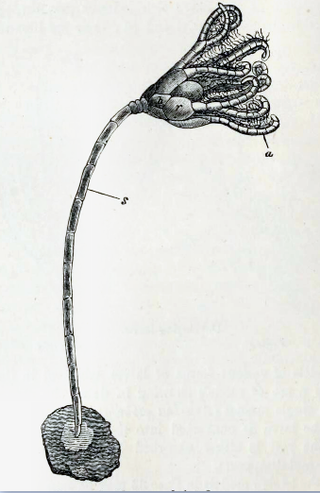
Antedon bifida is a species of crinoid in the family Antedonidae commonly known as the rosy feather star. It is found in north west Europe.

Comatulida is an order of crinoids. Members of this order are known as feather stars and mostly do not have a stalk as adults. The oral surface with the mouth is facing upwards and is surrounded by five, often divided rays with feathery pinnules. Comatulids live on the seabed and on reefs in tropical and temperate waters.
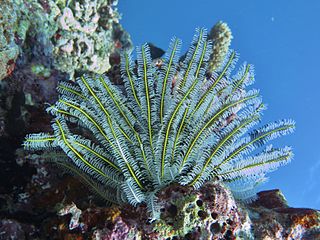
Comaster schlegelii, the variable bushy feather star, is a crinoid in the family Comatulidae. It was previously classified as Comanthina schlegeli but further research showed that it was better placed in the genus Comaster. It is found on shallow water reefs in the western Pacific Ocean.

Metacrinus rotundus, the Japanese sea lily, is a species of stalked crinoid in the family Isselicrinidae. It is a species found off the west coast of Japan, near the edge of the continental shelf at a depth of around 100 to 150 metres deep. This is the shallowest-living species among the extant stalked crinoids.

Anneissia bennetti, the Bennett's feather star, is a species of crinoid belonging to the family Comatulidae. It is found in shallow water in the Indo-Pacific between northern Australia and southeast Asia.

Antedon mediterranea is a species of stalkless crinoid in the family Antedonidae, commonly known as the Mediterranean feather star. It is found on the seabed at moderate depths in the Mediterranean Sea. It is a filter feeder and captures plankton with its long feathery arms.

Bourgueticrinida is an order of crinoids that typically live deep in the ocean. Members of this order are attached to the seabed by a slender stalk and are known as sea lilies. While other groups of crinoids flourished during the Permian, bourgueticrinids along with other extant orders did not appear until the Triassic, following a mass extinction event in which nearly all crinoids died out.

Cenocrinus is a monotypic genus of stalked crinoids in the family Isselicrinidae. The great West Indian sea lily is the only species in the genus and is found in deep waters in the Caribbean Sea and Gulf of Mexico.
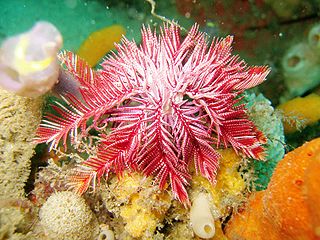
Ptilometra australis, the passion flower feather star, is a species of crinoid. It is native to the coasts of southeastern Australia where it is found on reefs, in estuaries and bays at depths down to about 110 metres (360 ft).
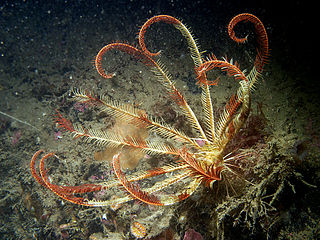
Leptometra is a genus of free-swimming, stemless crinoids.
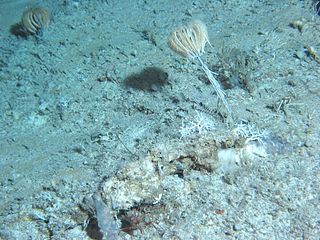
Endoxocrinus parrae is a species of stalked crinoids of the family Isselicrinidae. It is the most commonly found isocrinine species in west Atlantic Ocean.
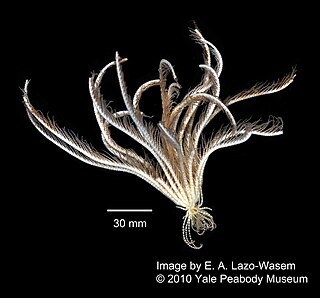
Promachocrinus kerguelensis is a species of free-swimming, stemless crinoids. It was the only member of its genus until several species were discovered in 2023. P. keruguelensis a coldwater crinoid which is found in the seas around Antarctica and surrounding island groups, including under the sea ice.

Aporometra wilsoni is a marine invertebrate, a species of crinoid or feather star in the family Aporometridae. It is found in shallow water around the coasts of southern Australia.

Notocrinus virilis is a marine invertebrate, a species of crinoid or feather star in the family Notocrinidae. It is found in deep water in the Southern Ocean around the coasts of Antarctica and adjacent islands. A sea snail sometimes parasitizes it.

Aporometra paedophora is a marine invertebrate, a species of crinoid or feather star in the family Aporometridae. It was first found at a depth of 22 fathoms off the Manning River on the New South Wales coast. Other specimens were found off the coast of Bunbury, Western Australia at depths between 9 and 15 m. Based on morphological evidence of four specimens of A. paedophora, Helgen & Rouse believe that this may not be a separate species from Aporometra wilsoni.

Neocrinus decorus is a species of stalked crinoid, or sea lily, in the family Isocrinidae.
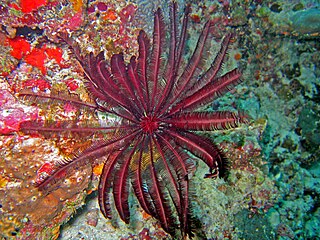
Cenometra bella is a species of crinoids belonging to the genus Cenometra. They can have up to 30 arms and can be of variable colours but are often characterised by a marked contrast between the extending free-arms and the feathery pinnules. This species clings to its support and moves around by its feet-like cirri.

Flexibilia is a superorder of specialized Paleozoic crinoids. They exhibited a conserved body plan and consistent suite of characteristics throughout their long history. Previously considered a subclass with unclear affinities, later investigation determined that flexibles are well-nested within Cladida, a broad group ancestral to living articulate crinoids. The Ordovician cladid Cupulocrinus acts as an intermediate form linking the generalized anatomy of other early cladids with the distinctive anatomy of flexibles, and several studies have considered it to be ancestral to the rest of the group. Although flexibles never reached the same abundance or diversity as many other crinoid groups, they remained a reliable component of crinoid faunas, particularly from the Silurian onwards. Flexible fossils are very rare in the Ordovician, but the Late Ordovician appears to have been an interval of rapid diversification for the group.



















